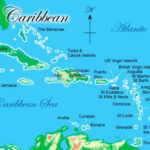Nestled high within the breathtaking Himalayas, Nepal has long captivated imaginations as a land of ancient mysteries and towering peaks. For years, its relative isolation only amplified its allure for intrepid travelers. Some even believe that Nepal’s Kathmandu Valley, with its serene beauty and spiritual ambiance, served as the inspiration for the mythical paradise of “Shangri-La” in James Hilton’s renowned 1933 novel, Lost Horizon. Today, Kathmandu is globally recognized as the vibrant capital of the Federal Democratic Republic of Nepal, a name that encompasses both the bustling city and the expansive valley it graces.
Unpacking the Name: Kathmandu’s Etymology
The name “Kathmandu” resonates with local heritage, believed to have been bestowed upon the region by the Pahari people, who constitute a significant portion of the population today. The name is almost certainly rooted in the iconic Kasthamandap Temple, a remarkable three-tiered pagoda that once stood proudly in the city’s Durbar Square. “Kastha” translates to “wood,” and “mandap” denotes a covered shelter or pavilion. Interestingly, “Kasthamandap” persists as an alternative name for the city in certain Buddhist texts, highlighting the temple’s profound social and historical importance. While legend dates the Kasthamandap Temple to the 16th century, archaeological findings suggest an even older structure on the site, possibly dating back to the 7th century. Sadly, this cherished temple succumbed to the devastating earthquake of 2015. Hopes remain high for its restoration, allowing it to reclaim its former splendor.
Pinpointing Kathmandu: Geographical Location
To answer the fundamental question, Where Is Kathmandu?, the metropolitan city is situated in the heart of the Kathmandu Valley, within Nepal’s Central District. Nepal itself is a landlocked, mountainous nation cradled between Tibet to the north and India to the south, straddling the majestic Himalayas. For those seeking to conquer the world’s highest peak, Mount Everest lies approximately 100 km to the east and slightly north of Kathmandu. This region is widely considered the gateway to the Himalayas, offering breathtaking vistas and access to unparalleled trekking adventures. Kathmandu sits at a significant elevation of around 1,400 meters (approximately 4,600 feet) above sea level, contributing to its unique climate and stunning panoramic views.
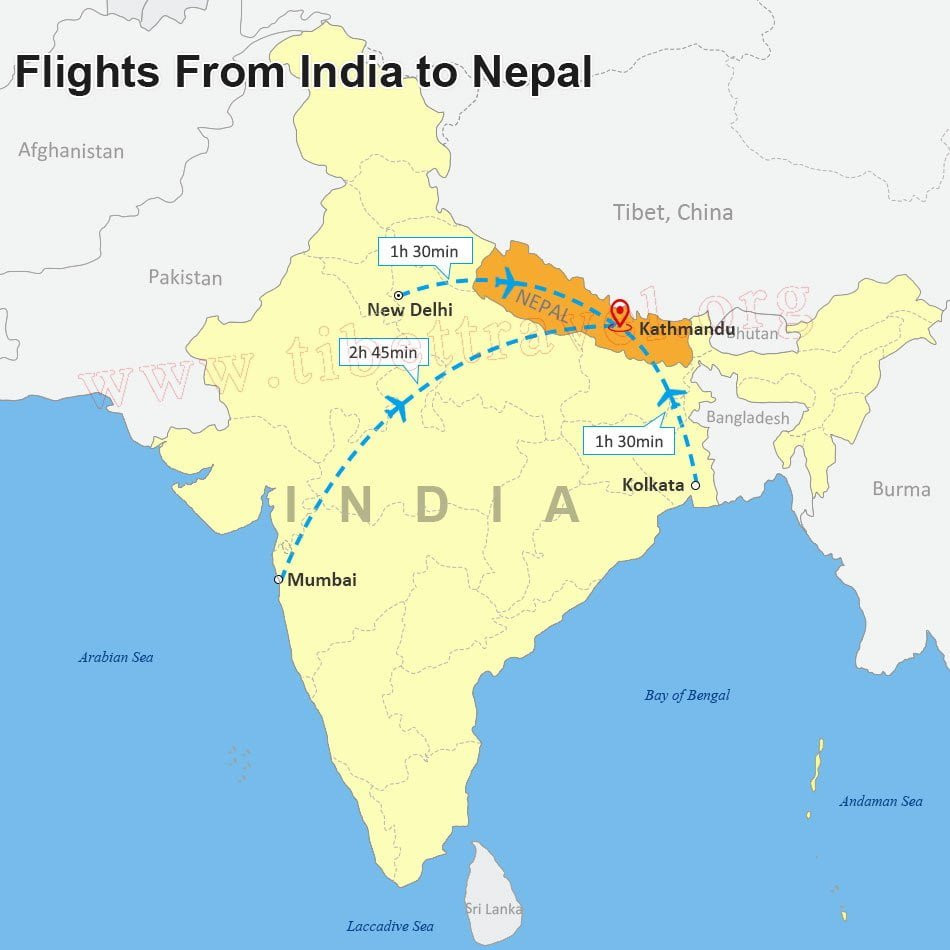 Where is Kathmandu on the map of Nepal?
Where is Kathmandu on the map of Nepal?
Decoding Kathmandu’s Climate: Weather Patterns
Kathmandu’s climate often surprises first-time visitors, who might anticipate extreme temperatures due to its altitude and inland continental location. Officially, the city and the Kathmandu Valley experience a “warm temperate” climate. While local variations exist due to differing altitudes and topography, summers generally see average temperatures between 28 to 30 degrees Celsius (82 to 86 degrees Fahrenheit). Winters are milder, with temperatures averaging around 10 degrees Celsius (50 degrees Fahrenheit), occasionally dipping below freezing. Rainfall also varies locally but averages around 1.4 meters (approximately 55 inches) annually. The majority of precipitation occurs during the monsoon season, spanning from June to August, with minimal rainfall during the winter months.
Navigating Time in Kathmandu: Time Zone
For travelers planning their itinerary, understanding Kathmandu’s time zone is crucial. The Internet Assigned Numbers Authority (IANA) designates Kathmandu within the Asia/Kathmandu zone. This time zone is commonly known as Nepal Time (NPT), which is set to UTC + 5:45. This unique time difference reflects Nepal’s specific geographical location and historical timekeeping.
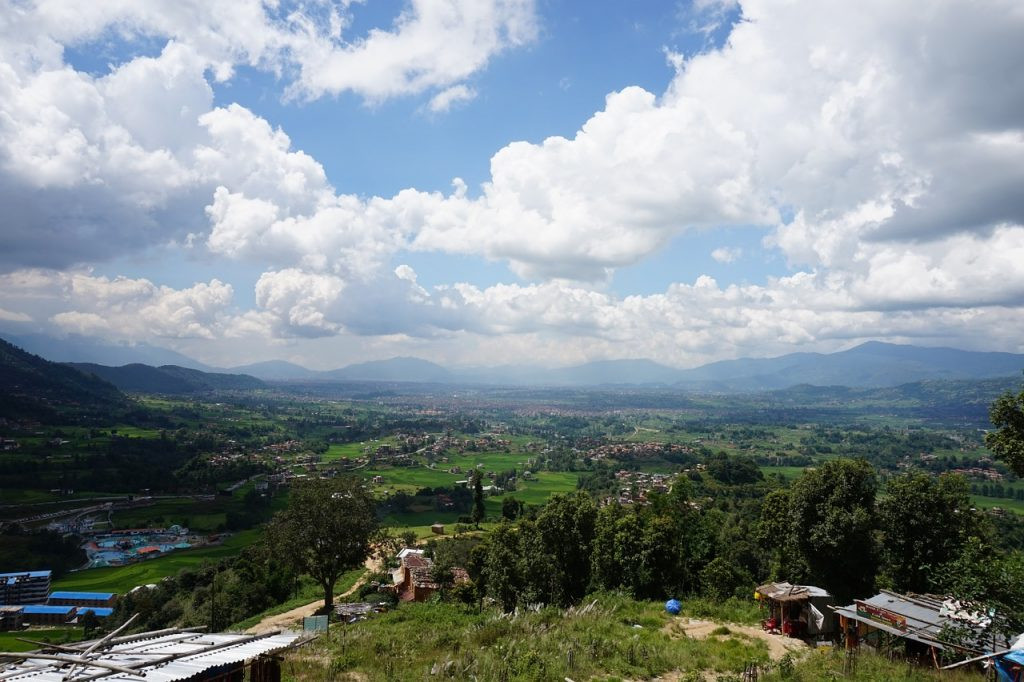 Aerial view of the Kathmandu Valley in Nepal
Aerial view of the Kathmandu Valley in Nepal
Arriving in Kathmandu: Airport Information
Kathmandu is readily accessible by air via Tribhuvan International Airport (KTM), the city’s own airport. KTM serves as a vital aviation hub, currently operating 9 scheduled domestic routes within Nepal and 35 scheduled international routes, connecting Kathmandu to various corners of the globe. The airport boasts a single runway capable of accommodating aircraft of all sizes, including night landings, ensuring smooth and efficient air traffic. Direct scheduled flights are available from numerous international airports, including major hubs like Delhi, Kuala Lumpur, Dubai, and Seoul, making Kathmandu increasingly accessible to international travelers.
Exploring the Kathmandu Valley: Metropolitan Area
While Kathmandu metropolitan city is a sprawling urban center with evolving boundaries, it’s essential to recognize that it’s part of a larger entity – the Kathmandu Valley. The city itself is home to approximately 1.5 million residents, but the Kathmandu Valley encompasses several other significant cities and towns, including Patan, Bhaktapur, Madhyapur Thimi, Kirtipur, and Lalitpur. The suffix “pur” in these names simply translates to “place.” Numerous smaller villages also dot the valley, contributing to a total population of around 5 million in the Kathmandu Valley region. The valley’s distinctive bowl-like shape is a result of an ancient lakebed. The land is remarkably fertile, and coupled with favorable weather patterns, it’s ideally suited for agriculture. This agricultural abundance likely played a significant role in the valley’s selection as a population center throughout history.
The Kathmandu Valley boasts a rich history of human settlement spanning millennia. Despite its apparent isolation amidst towering mountains, it has long been a welcoming crossroads for visitors from diverse regions. Kathmandu flourished as a major trading post along the Silk Road, facilitating east-west commerce. Positioned on a crucial spur route connecting Tibet and India, the city not only facilitated the exchange of goods but also became a melting pot of cultures and religions. Present-day Kathmandu embraces its multi-ethnic identity, characterized by respect and tolerance among its diverse communities. Hinduism is the predominant religion, practiced by approximately 70% of the population, followed by Buddhism at 20%, with the remaining 10% encompassing various other faiths.
Kathmandu’s Architectural Wonders: Ancient Sites
Kathmandu frequently attracts adventurous tourists drawn to its breathtaking mountain landscapes and vibrant cultural tapestry. Many visitors are also drawn by the spiritual aura of the region, seeking enlightenment amidst ancient temples and monasteries. Regardless of their motivations, visitors are invariably captivated by the sheer abundance of ancient monuments, palaces, and temples that adorn the city. Kathmandu is a place where art and religion have seamlessly converged, manifesting in magnificent architectural expressions. UNESCO has formally recognized the exceptional significance of these ancient sites, designating seven Monument Zones as World Heritage Sites.
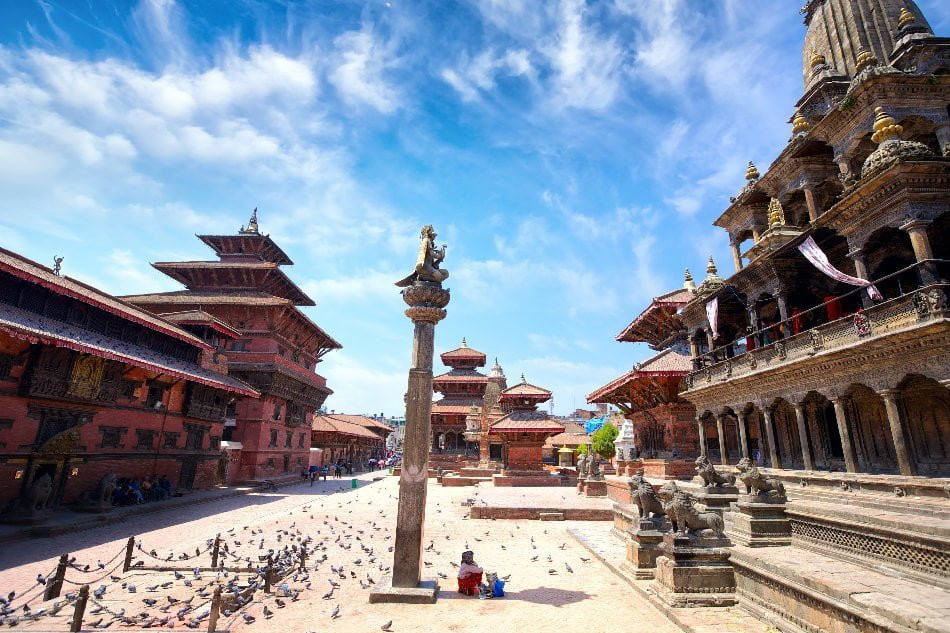 The historic Durbar Square in Kathmandu, Nepal
The historic Durbar Square in Kathmandu, Nepal
The architectural treasures of Kathmandu extend far beyond these designated zones, which essentially represent concentrated areas brimming with national treasures. Some of these zones are known as “Durbar Squares,” meaning “Place of Palaces.” Others showcase revered Hindu Temples or iconic Buddhist Stupas (dome-shaped religious structures). Kathmandu’s Durbar Square, also known as Hanuman Dhoka, is a sprawling complex housing fifty temples arranged within two quadrangles. Similar Durbar Squares can be found in the satellite towns of Bhaktapur and Patan, each offering unique architectural marvels.
Some of Kathmandu’s Hindu temples boast astonishing antiquity, with the Changu Narayan Temple dating back to the 4th century and the pagoda-style Pashupatinath Temple tracing its origins to the 5th century. Buddhist stupas, instantly recognizable by their distinctive dome shape, are equally prominent. Boudhanath stands as one of the largest stupas in existence, earning UNESCO World Heritage Site status in 1979. Swayambhu, another frequently visited stupa, is revered by both Buddhists and Hindus. Notably, the superstructure atop Swayambhu’s dome incorporates four iconic representations of Buddha’s eyes, each gazing in a different cardinal direction. Due to its resident monkey population, this stupa is affectionately known as the Monkey Temple.
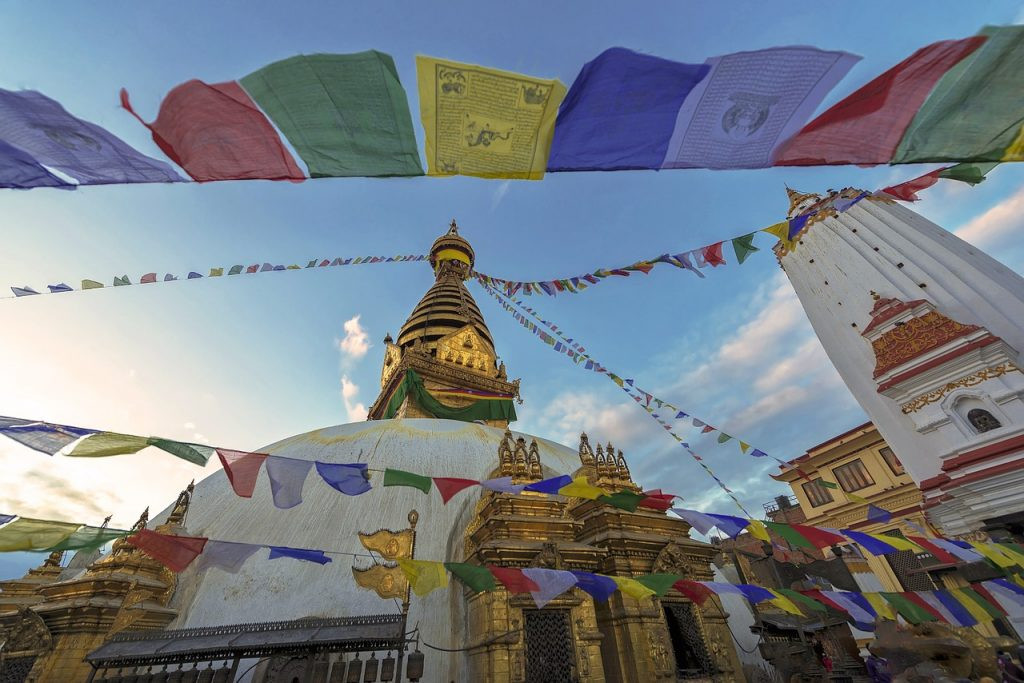 The revered Buddhist Stupa of Swayambhu, also known as the Monkey Temple, in Kathmandu
The revered Buddhist Stupa of Swayambhu, also known as the Monkey Temple, in Kathmandu
The devastating 2015 earthquake inflicted damage upon many of Kathmandu’s architectural gems, with some buildings tragically collapsing completely. The Nepalese government has expressed its commitment to rebuilding all damaged structures, an ambitious undertaking that is expected to take many years, particularly for sites like Kathmandu’s Durbar Square to fully regain their pre-earthquake condition. It’s important to note that the majority of buildings survived the earthquake, and while visitors may observe ongoing restoration efforts, the overall character of the area remains largely intact. However, the full extent of the architectural damage may not be immediately apparent. Even official tourism resources may downplay the impact, sometimes mentioning only the collapse of “a couple of old temples.” For a comprehensive understanding, the following is a list of buildings known to have been completely destroyed in the 2015 earthquake, whose reconstruction will be a lengthy and intricate process:
- Kasthmandap
- Maju Dega and Narayan Vishnu Temples
- Trailokya Mohan
- Krishna (Chasin Dega)
- Dharahara (Bhimsen Tower)
- Hari Shankar
- Jagan Narayan
- Vatsala Durga Temple
- Fasidega Temple
Numerous other buildings sustained damage but were deemed repairable.
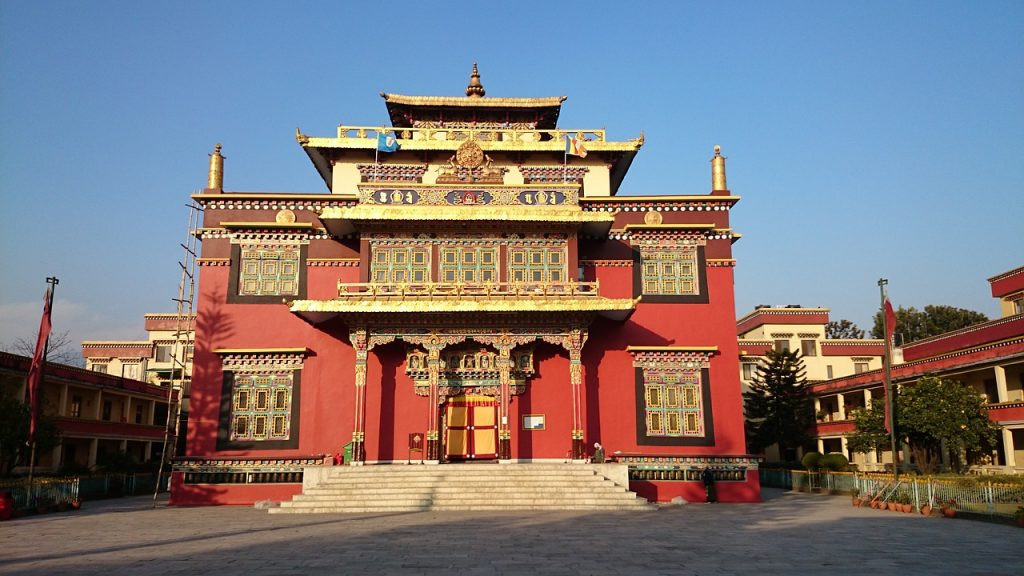 The serene Shechen Tennyi Dargyeling Monastery in Kathmandu
The serene Shechen Tennyi Dargyeling Monastery in Kathmandu
Safety in Kathmandu: Is it Safe to Visit?
Prospective travelers often inquire about safety when considering a visit to a densely populated city. However, Kathmandu stands out as an exceptionally safe destination in terms of personal crime. It ranks among the safest cities globally, with local residents renowned for their warm hospitality and welcoming attitude towards visitors. A cherished local motto, “Atithi Devo Bhava,” meaning “Guest is equivalent to God,” reflects the deep-seated respect and high regard Kathmanduites hold for their guests.
From a health perspective, visitors should ensure they are up-to-date on all recommended vaccinations. It’s advisable to avoid drinking untreated tap water. Air pollution can be a concern in some of the most congested areas, so individuals with respiratory sensitivities may want to take precautions. Earthquake risk is another factor to consider. As Kathmandu lies in a seismically active region, tremors are relatively common, although major earthquakes are statistically infrequent. Prior to the 2015 earthquake, a similar magnitude event occurred in 1934. Earthquake-related casualties often result from collapsing structures or landslides, so it’s prudent to avoid potentially hazardous locations and always be aware of emergency exits in buildings.
Communication and Currency in Kathmandu: Practicalities
Kathmandu’s cosmopolitan nature is reflected in its linguistic diversity. Nepali is the most widely spoken language, but English is also widely understood, particularly in tourist areas. The official currency is the Nepalese Rupee (NPR). It’s generally challenging to obtain NPR outside of Nepal, but currency exchange services are readily available at the airport. However, more favorable exchange rates can often be found within the city itself. Therefore, it’s advisable to exchange only a small amount at the airport for immediate expenses like taxis or meals and handle larger currency exchanges later in the city. US dollars are sometimes accepted for smaller transactions and tips, so carrying a small amount of USD can also be useful.
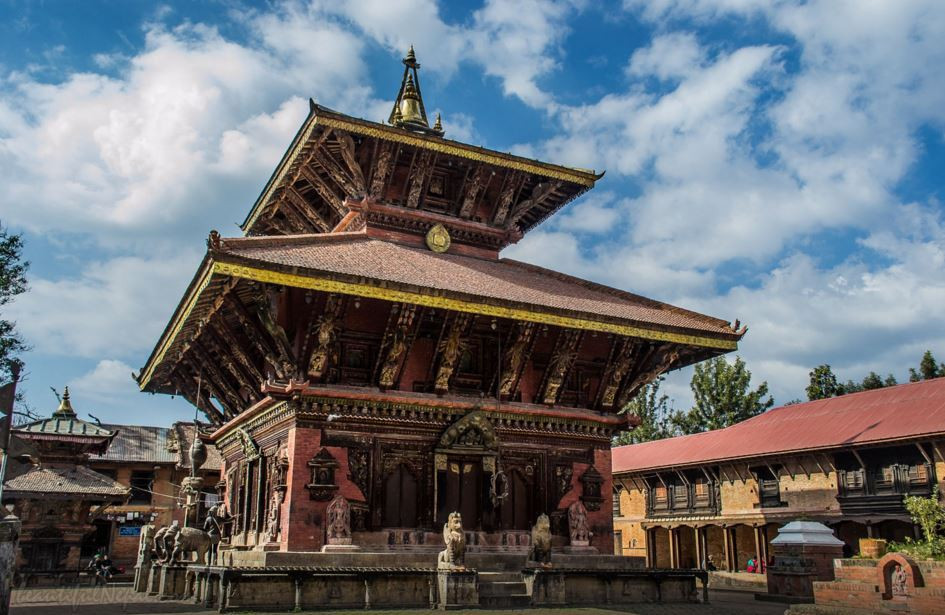 The ancient Changu Narayan Temple, a UNESCO World Heritage Site, in Kathmandu
The ancient Changu Narayan Temple, a UNESCO World Heritage Site, in Kathmandu
Experiencing Kathmandu: Tourism and Activities
While tourism in Kathmandu truly gained momentum in the 1950s, the city has a long history of welcoming traders and pilgrims from across the globe. During the 1960s and 70s, Kathmandu became a popular destination for the “hippie trail” generation and independent travelers. Today, it firmly occupies a prominent place on the mainstream tourist map, offering a wide range of accommodations, including luxury hotels like the Hyatt Regency, Hotel Radisson, The Everest Hotel, Hotel De L’Annapurna, and Hotel Yak and Yeti, some of which even feature casinos. More budget-friendly options are also widely available. Beyond historical sites, popular tourist areas include whimsically named Freak Street (officially Jhochhen Tol), Thamel, and Jhamel (Jhamsikhel), all brimming with shops, hotels, and restaurants. Shopping opportunities abound, but it’s customary and expected to haggle over prices, as initial offers to tourists are often inflated compared to local prices.
Immersing in Kathmandu’s Culture: Festivals and People
Kathmandu is a vibrant city pulsating with activity at all times, but visiting during one of its numerous festivals offers an especially enriching experience. Most of Kathmandu’s festivals are deeply rooted in religious traditions, dating back centuries, offering a captivating glimpse into the past. With an astounding 133 different festivals celebrated annually, there’s always a high probability of witnessing at least one of these remarkable spectacles during a visit. A more recent addition to the festival calendar is the Kathmandu Jazz Festival (established in 2002), also known as “Jazzmandu,” showcasing the influence of Western music.
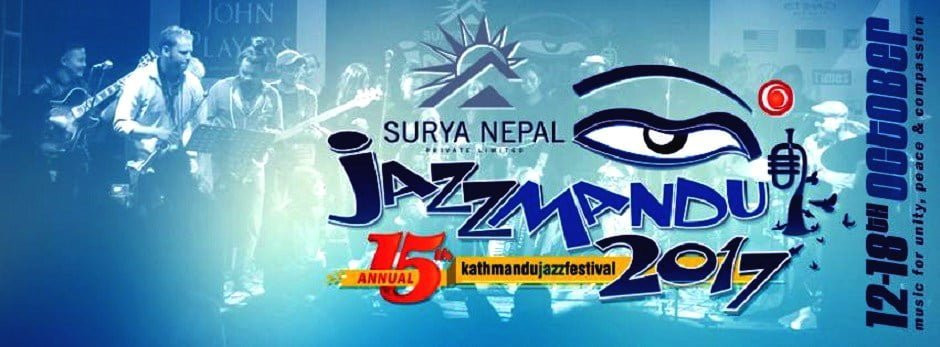 A vibrant scene from the Kathmandu Jazz Festival, Jazzmandu
A vibrant scene from the Kathmandu Jazz Festival, Jazzmandu
Many goods offered for sale in Kathmandu are exquisite examples of traditional crafts and skills. Visitors can even participate in workshops to learn some of these skills and create truly unique souvenirs. Kathmandu is a global hub of exceptional artistry and craftsmanship, even credited as the birthplace of the pagoda-style architecture that later spread to China. However, what truly distinguishes Kathmandu is its people, who are genuinely among the friendliest in the world. When greeting a Kathmanduite, a simple gesture of pressing hands together and uttering “Namaste” is often enough to forge an instant connection, invariably met with a warm smile and a reciprocal “Namaste.” This Sanskrit word, meaning “The divine in me bows to the divine in you,” encapsulates the profound respect and hospitality that permeate this extraordinary place.
The 2015 Kathmandu Earthquake: Resilience and Recovery
On April 25, 2015, a major earthquake struck the region, registering 7.8 on the Richter scale. It was one of the most devastating earthquakes ever recorded in Nepal, followed by hundreds of aftershocks in the subsequent days. On May 12, a further significant earthquake of 7.3 magnitude occurred. These earthquakes resulted in tragic loss of life and widespread structural damage. Many people lost their homes, and the country continues to grapple with the long-term consequences of this catastrophe. Media coverage at the time understandably highlighted scenes of devastation, leading some to believe that Kathmandu had been entirely flattened. However, this was not the reality. While significant damage occurred, most structures remained relatively unscathed. Kathmandu has demonstrated remarkable resilience and is very much operational today, with life proceeding as usual.
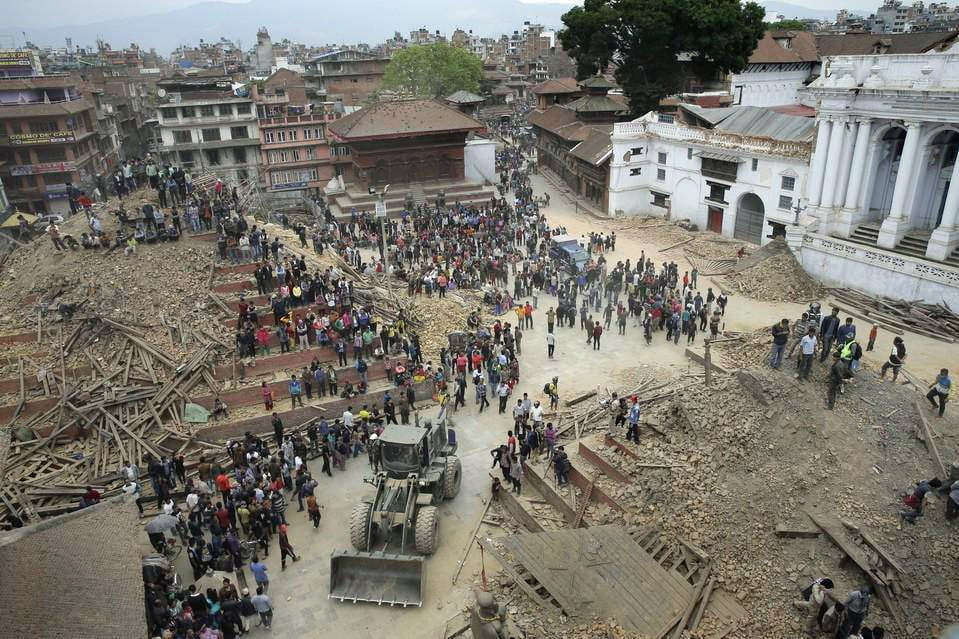 The aftermath of the devastating 2015 earthquake in Kathmandu
The aftermath of the devastating 2015 earthquake in Kathmandu
Understanding Kathmandu’s Seismicity: Earthquake Causes
The frequent occurrence of earthquakes in this mountainous region is not coincidental. They are a result of tectonic movements, specifically the collision and compression of tectonic plates, leading to fracturing known as “faulting.” Kathmandu is situated in a zone where two major tectonic plates converge: the Indian section of the Indo-Australian plate and the Eurasian plate. The Indian plate is subducting, meaning it’s being forced underneath the Eurasian plate. This ongoing process involves a lateral movement of 4-5 cm per year, and the Himalayan mountain range continues to rise by approximately 1 cm annually. This constant upward thrust has sculpted the world’s highest mountain range.
Kathmandu is an enthralling destination that appeals to a wide spectrum of travelers, captivating the mind, heart, and spirit. Despite being a modern city, visitors quickly discover that they are just steps away from a world seemingly untouched by time. Kathmandu is a place where history is not confined to museums but lives on as an integral part of everyday life… a genuine Shangri-La waiting to be explored.

